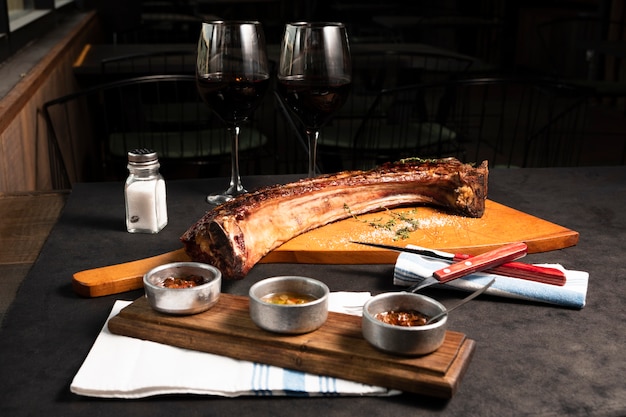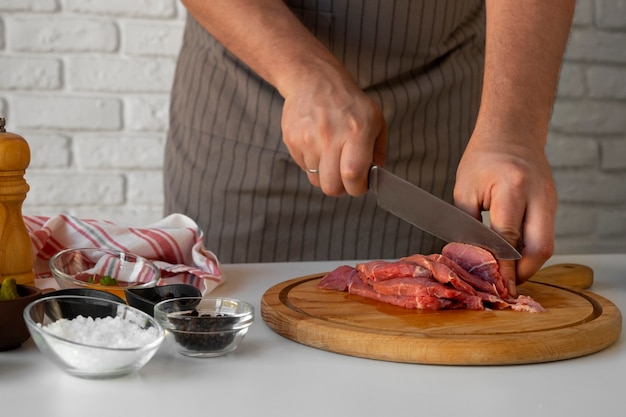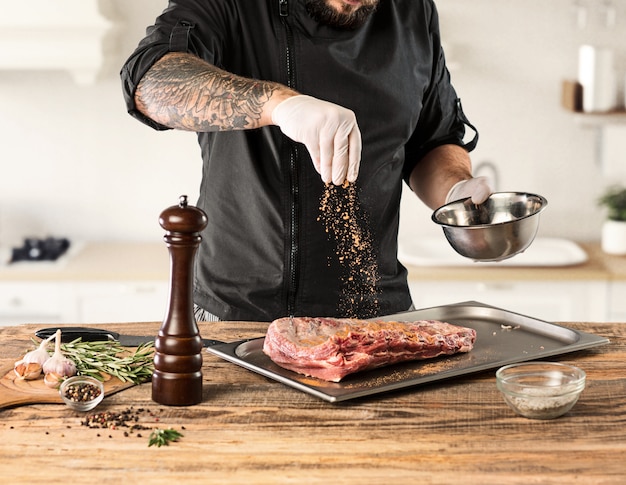Let's be honest, brisket can seem intimidating. This massive slab of meat, the king of the BBQ world, demands hours of dedicated cooking. But trust me, once you've tasted a perfectly cooked brisket, you'll be hooked. The meltingly tender, juicy meat, bursting with smoky flavour… it's truly a revelation. It's like a hug from your grandma and a taste of pure happiness all rolled into one.
I've been a brisket fanatic for years, trying out countless recipes, experimenting with different rubs and techniques. I've learned a few things along the way, and I want to share them with you. This isn't just about throwing meat on the BBQ and hoping for the best. It's about understanding the science behind it, the techniques, the patience, the dedication – and of course, the love! So, if you're ready to embark on this brisket adventure, grab your apron, fire up the BBQ, and let’s get started!
(Part 1) The Brisket: Choosing Your Weapon

The Cut: Point vs. Flat
First things first, we need to choose our brisket. You'll usually find two main types:
- Point Cut: This is the "fatty" part of the brisket. It's packed with flavour and, due to its fat content, incredibly tender. Imagine a buttery, melt-in-your-mouth experience – that's the point cut.
- Flat Cut: This is the leaner option, known for its even texture. It's a bit more challenging to cook perfectly, as it can dry out easily. But fear not, we'll conquer this challenge together!
I'm a purist, I love the flavour of a good point cut. It's simply incredible! But for a more well-rounded experience, consider a packer brisket, which combines the point and flat cut. It's a bit pricier, but the combination of flavours and textures is unbeatable! You get the best of both worlds.
Size Matters: Feeding the Crowd
Now, let's talk size. You want a brisket that's big enough to feed your crowd, but not so massive that you'll be eating brisket for a week. A brisket between 10 and 15 pounds is a good starting point. You can always adjust based on your needs. I have a few mates who could polish off a whole brisket themselves, so you’ve got to be prepared for anything!
Butcher's Choice: The Key to Success
Your butcher is your best friend in this process. Ask for a brisket that's well-marbled. You want to see a good amount of fat running through the meat. This fat will render during cooking, adding amazing flavour and juiciness. Don't be afraid to ask for advice from your butcher. They're experts! And trust me, a little chat with your butcher can make all the difference.
(Part 2) The Rub: Your Brisket's Secret Weapon

So, you've got your brisket! Now, it's time to give it a rub. Think of the rub as the brisket's perfume. It's the first layer of flavour that will permeate the meat during cooking. You want to create a symphony of flavour, not a cacophony of spice.
Basic Rub: The Foundation of Flavor
You can find endless rub recipes online, but a good basic rub should include:
- Salt: Essential for flavour and draws moisture out of the meat, helping it stay tender.
- Black Pepper: Adds a little heat and depth of flavour, creating a classic BBQ kick.
- Paprika: Smoky flavour, adds colour and a touch of sweetness, making it a must-have for a good rub.
- Garlic Powder: A classic addition that adds a savoury aroma, bringing a touch of warmth.
- Onion Powder: Another classic, adds a bit of sweetness and depth to the rub, bringing a balanced taste.
Now, this is your chance to get creative! You can add other spices like cayenne pepper, cumin, chili powder, brown sugar, or even herbs like thyme or rosemary. Go wild, experiment! Just make sure the flavours complement each other. Remember, it's about creating a symphony of flavour, not a cacophony of spice. A good rub is all about balance.
Applying the Rub: A Touch of TLC
Once you’ve got your rub, it’s time to apply it generously to the brisket. Massage it into the meat, ensuring every inch is covered. You want to make sure the rub adheres to the meat. I like to let the brisket sit in the fridge overnight with the rub, letting those flavours really seep in. It's like giving the brisket a long, relaxing massage before its big day.
(Part 3) The Smoke: Getting That BBQ Magic

Now, here's where the real magic happens. We're going to slow-smoke that brisket. Think of it as a long, slow love affair between your brisket and the smoker. This is where patience comes in, and where the aroma of hickory and oak wood will start to fill your backyard. Just imagine, the sweet scent of smoke swirling around you, that’s the stuff of BBQ dreams, right?
The Smoker: Your BBQ Buddy
A good smoker is your best friend in this process. I'm a huge fan of offset smokers; they deliver that authentic BBQ taste and are so versatile. You can also use a gas grill or even a wood-fired oven if you're feeling adventurous. But let’s be honest, a good smoker is a BBQ lover's dream come true.
Fuel for the Fire: Wood Matters
Now, the wood you choose will add its own unique flavour to your brisket. I’m a big fan of hickory, it adds a rich, smoky flavour that works beautifully with beef. Oak, pecan, and mesquite are other popular choices. You can even experiment with different woods to create your signature blend of flavours. Go on, get adventurous! Experiment with different wood blends, maybe even a bit of applewood for a slightly sweeter flavour. It's all part of the fun!
Setting the Stage: Low and Slow
We're going to build a low and slow fire. You're aiming for a temperature between 225-250 degrees Fahrenheit (107-121 degrees Celsius). This is where your smoker's temperature control comes into play. You want to maintain this low and steady temperature for a long time, because that's what ensures the meat stays juicy and tender. And trust me, you don’t want to rush this process, it’s all about patience.
(Part 4) The Wait: Patience Is a Virtue
Alright, the brisket is in the smoker, the fire is going, and now comes the long wait. This is where you put on your most comfortable clothes, grab a good book, and relax. The brisket will be in the smoker for a good 10-12 hours, depending on the size. It’s all about slow and low cooking, my friend. The key is to let the smoke work its magic, penetrating the meat and breaking down the connective tissues, leading to that melt-in-your-mouth tenderness we all crave. It’s worth the wait, I promise you.
The Stall: A Brisket Mystery
You'll likely encounter what's known as the "stall." This is where the internal temperature of the brisket plateaus and seems to refuse to rise any further. It can be frustrating, I know, but don’t panic. It’s actually a good sign! This stall is simply the meat's natural defense mechanism. It's trying to retain moisture. The best way to overcome the stall? Patience! Simply keep the smoker going, and eventually, the internal temperature will start to rise again. It can be a little frustrating, I know, but trust me, it's worth the wait. The stall is a crucial part of the process. It allows the brisket to break down, become more tender, and soak up all that delicious smoky flavour.
The Wrap: A Secret Weapon
Once your brisket has reached about 160 degrees Fahrenheit (71 degrees Celsius), it's time to wrap it. This helps to speed up the cooking process and ensure the meat stays moist. I like to wrap my brisket in butcher paper, as it breathes better than foil. You can also use aluminum foil if you prefer, just make sure it's not too tightly wrapped. Now, let the brisket rest in its cozy paper blanket for another couple of hours. This will allow the meat to continue cooking and become even more tender.
(Part 5) The Rest: A Crucial Step
Okay, so your brisket is cooked, it's resting, and you're probably starting to get those BBQ cravings. But hold your horses! The brisket needs time to rest before you carve it. This is a crucial step, it allows the juices to redistribute throughout the meat, resulting in a much more flavorful and juicy cut. Trust me on this one. At least an hour is ideal, but even two hours will make a world of difference. It’s like giving the brisket a chance to catch its breath and settle in. And while you're waiting, you can start prepping your sides!
(Part 6) The Carve: An Art Form
Now, the moment of truth. It’s time to carve that brisket! You want to be careful here, it’s super tender. You don’t want to shred it to pieces. I like to start by carving it across the grain, slicing into nice, even slices. You can then pull the meat apart for a more rustic look, or leave it in slices for a more elegant presentation. This is where you really get to showcase your BBQ skills!
The Fat Cap: A Delicious Bonus
Don’t forget the fat cap! It’s a treasure trove of delicious flavour. You can cut it into smaller pieces and add it to the rest of the brisket, or use it to make a delicious pan sauce for your sides. Trust me, it's so tasty!
(Part 7) The Sauce: Finishing Touches
Alright, your brisket is carved, your sides are ready, and now it’s time for the finishing touches – the sauce! Now, some people prefer to skip the sauce altogether, and that’s totally fine. The brisket is delicious all on its own. But for those who want to add a little something extra, a good bbq sauce is a must. And here’s the secret - a simple sauce is often best. You want a sauce that enhances the flavours of the brisket, not overpower them.
Classic BBQ Sauce: A Timeless Classic
A good, classic BBQ sauce should have a balance of sweetness, tang, and smokiness. You can find endless variations, but a simple recipe includes:
- Tomato Ketchup: The base of your sauce, provides tang and sweetness, creating a classic BBQ flavour.
- Apple Cider Vinegar: Adds tang and a hint of sweetness, balancing the sweetness of the ketchup.
- Worcestershire Sauce: Adds savoury depth and a touch of umami, enhancing the overall flavour profile.
- Brown Sugar: Provides sweetness and caramel flavour, rounding out the taste and adding a hint of depth.
- Black Pepper: Adds a little heat and depth of flavour, giving the sauce a classic BBQ kick.
Smoky BBQ Sauce: For a Smoky Kick
If you’re looking for a more smoky flavour, try adding a splash of liquid smoke to your sauce, or even a tablespoon of smoked paprika. The smoky flavour will really elevate your brisket.
Sweet and Tangy: A Balance of Flavors
For a sweeter and more tangy sauce, you can add a little honey or molasses. And for a hint of spice, add a pinch of cayenne pepper or a tablespoon of chili powder. The possibilities are endless, you can really create your signature sauce that perfectly complements your brisket. Remember, it's all about finding the perfect balance of flavors.
(Part 8) Serving Up Your Masterpiece
Okay, you’ve conquered the brisket, you’ve mastered the sauce, and now it’s time to serve up your BBQ masterpiece! Don't forget the sides. I’m talking coleslaw, baked beans, potato salad - all the BBQ classics. And don’t forget to set out a generous stack of napkins, because you’ll be needing them!
Presentation Matters: Making a Statement
It’s time to put on your BBQ chef hat, because the presentation is important. A beautifully carved brisket, piled high on a platter with your favourite sides, will make a real statement. Don’t be afraid to get creative. You could add a little flourish with a sprig of rosemary or a slice of lemon. It’s all about creating a stunning BBQ experience!
Enjoy the Feast!: Time to Celebrate
And finally, it’s time to enjoy the fruits of your labour! Take a moment to appreciate the effort, the time, and the love you poured into making that brisket. Gather your friends and family around, share stories, and savour every delicious bite. This is what BBQ is all about!
FAQs
1. How long does it take to cook a brisket?
A brisket can take anywhere from 10 to 12 hours, depending on the size and your preferred cooking method. It's a slow and steady process. But trust me, it's worth the wait! The longer you cook it, the more tender and flavorful it becomes.
2. Can I use a gas grill to cook a brisket?
Absolutely! A gas grill can work great for smoking a brisket, but it's important to choose a grill with good temperature control. You'll need to maintain a low and slow temperature for the best results. You can also use a smoker box to add wood chips for that authentic smoky flavor.
3. How do I know when my brisket is done?
You'll know your brisket is done when it reaches an internal temperature of at least 195 degrees Fahrenheit (90 degrees Celsius). The meat should be very tender and easily pull apart. You can also use a probe to check for tenderness, a good indicator is when it meets no resistance. If you're feeling adventurous, you can even try the "finger-poke" test. If you can poke the brisket with your finger and it feels like butter, you're good to go.
4. What should I do if my brisket stalls?
Don't panic! The stall is a normal part of the brisket cooking process. Just keep the smoker going at a low and steady temperature, and the brisket will eventually continue cooking. It can take a few hours, but be patient! It's all part of the process, and the result will be worth it.
5. How can I make my brisket extra juicy?
Using a point cut brisket is a good start, as it has more fat. Make sure you rub the brisket generously with salt, as it helps retain moisture. Wrapping the brisket in butcher paper or foil towards the end of the cooking process can also help to lock in moisture. And don't forget to let the brisket rest for at least an hour before carving to allow the juices to redistribute.
Everyone is watching

Prime Rib Roast Cooking Time Chart: Per Pound Guide
Cooking TipsPrime rib roast. Just the name conjures images of lavish dinners, crackling fires, and hearty laughter. It’s ...

How Long to Bake Potatoes in the Oven (Perfect Every Time)
Cooking TipsBaked potatoes are a staple in my kitchen. They're incredibly versatile, delicious, and surprisingly easy to m...

Perfect Rice Every Time: The Ultimate Guide to Cooking Rice
Cooking TipsAs a self-proclaimed foodie, I've always been a bit obsessed with rice. It's the foundation of countless cuisi...

The Ultimate Guide to Cooking Asparagus: Tips, Techniques, and Recipes
Cooking TipsAsparagus. The mere mention of this spring delicacy conjures up images of vibrant green spears, crisp and burs...

Ultimate Guide to Cooking the Perfect Thanksgiving Turkey
Cooking TipsThanksgiving. Just the word conjures up images of overflowing tables laden with delicious food, the scent of r...
